Operating Performance Management Programme: Challenges and Solutions
VerifiedAdded on 2019/09/20
|15
|3624
|98
Report
AI Summary
This report delves into the multifaceted challenges encountered in operating performance management within a global context. It begins by establishing a foundation with theoretical perspectives on leadership, motivation, change management, and managing diversity, highlighting their significance in international settings. The core of the report focuses on identifying and analyzing specific challenges, including the complexities of aligning company-wide goals with specific area performance, standardizing versus customizing performance metrics, ensuring uniformity of data, accounting for environmental variations, and addressing issues of performance criteria validity, time and distance variations, varied levels of employee maturity, and rater bias. Finally, the report proposes various methods and strategies to effectively address these challenges, culminating in a comprehensive conclusion that underscores the importance of adaptable and culturally sensitive performance management practices.
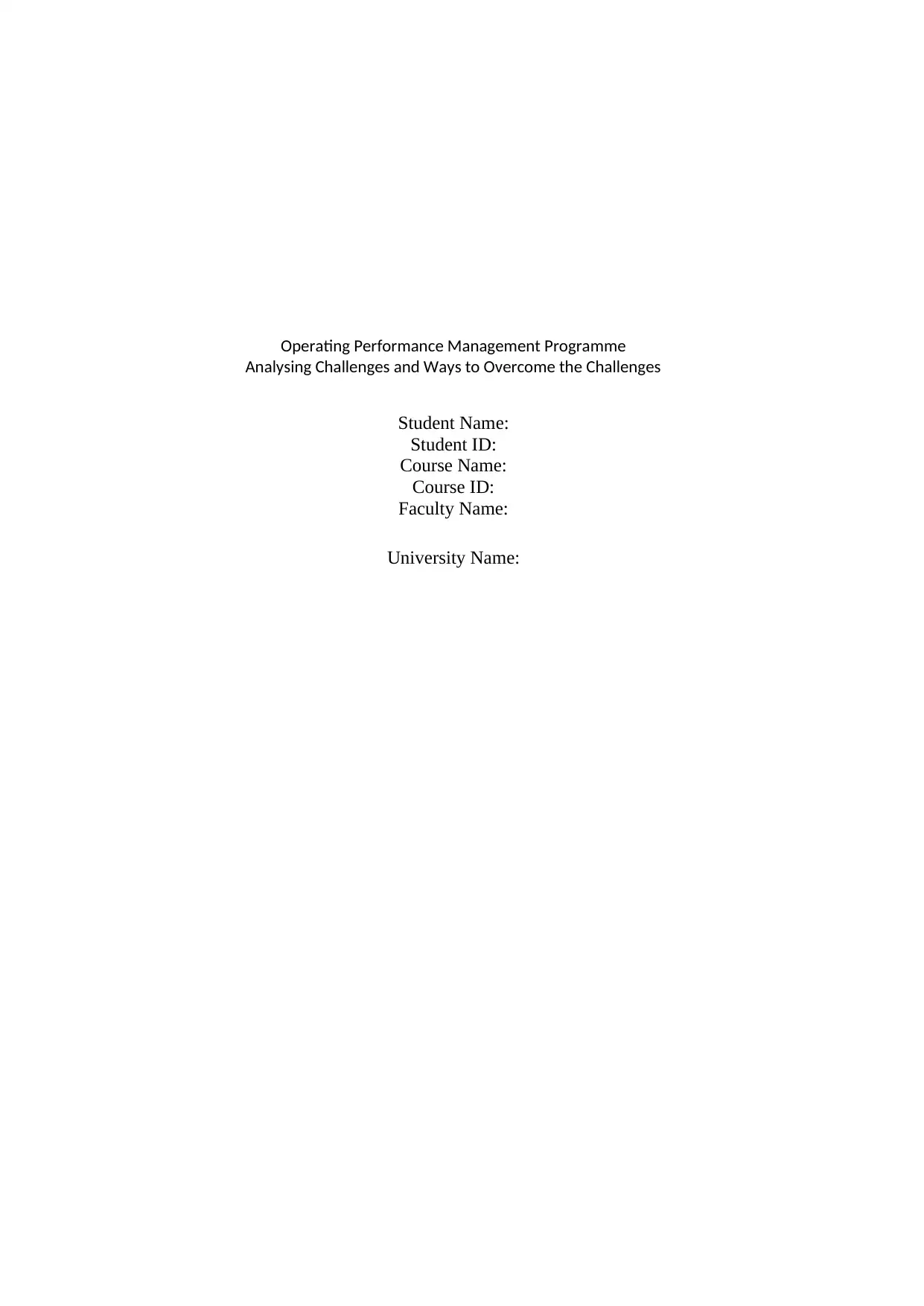
Operating Performance Management Programme
Analysing Challenges and Ways to Overcome the Challenges
Student Name:
Student ID:
Course Name:
Course ID:
Faculty Name:
University Name:
Analysing Challenges and Ways to Overcome the Challenges
Student Name:
Student ID:
Course Name:
Course ID:
Faculty Name:
University Name:
Paraphrase This Document
Need a fresh take? Get an instant paraphrase of this document with our AI Paraphraser
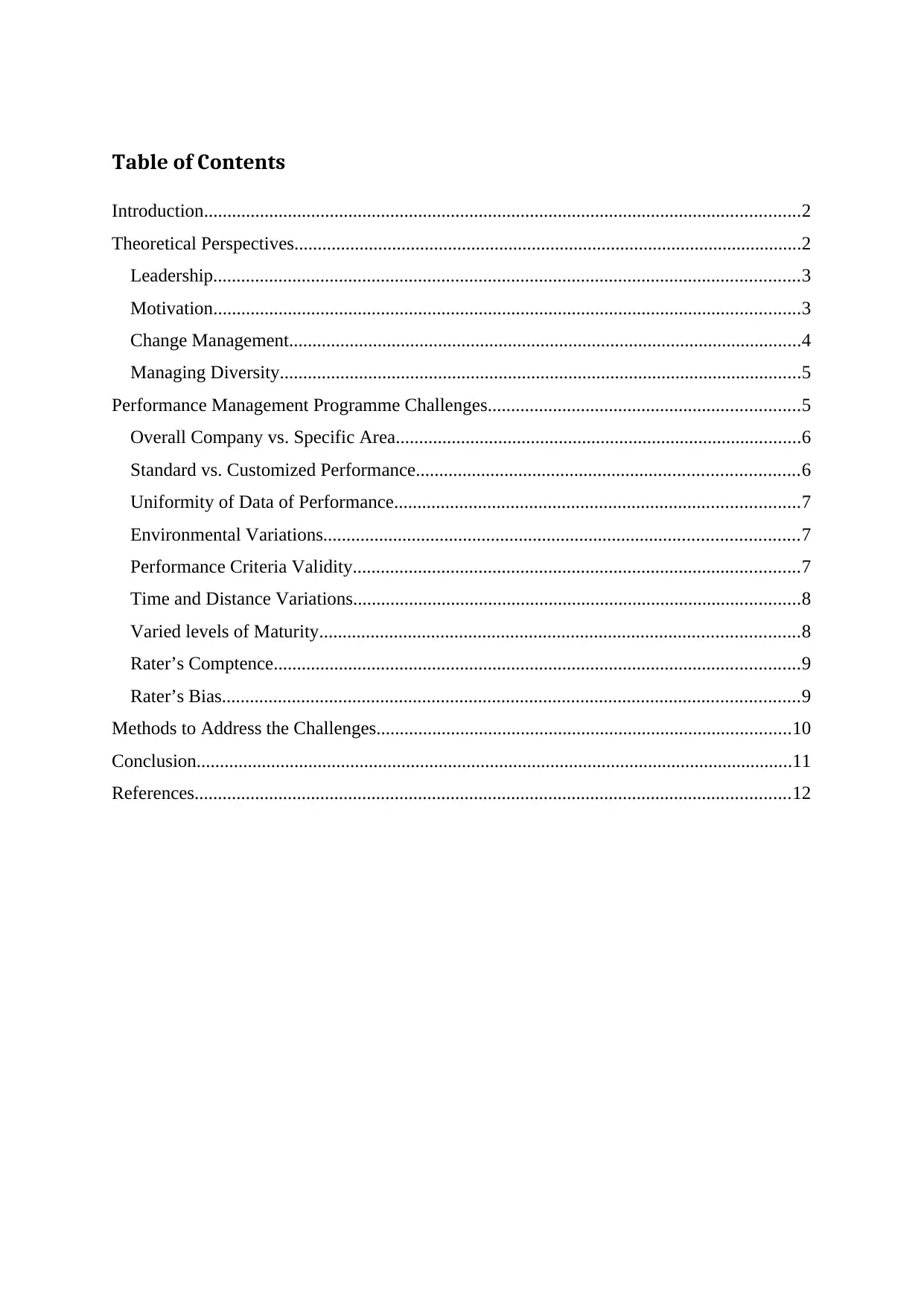
Table of Contents
Introduction................................................................................................................................2
Theoretical Perspectives.............................................................................................................2
Leadership..............................................................................................................................3
Motivation..............................................................................................................................3
Change Management..............................................................................................................4
Managing Diversity................................................................................................................5
Performance Management Programme Challenges...................................................................5
Overall Company vs. Specific Area.......................................................................................6
Standard vs. Customized Performance..................................................................................6
Uniformity of Data of Performance.......................................................................................7
Environmental Variations......................................................................................................7
Performance Criteria Validity................................................................................................7
Time and Distance Variations................................................................................................8
Varied levels of Maturity.......................................................................................................8
Rater’s Comptence.................................................................................................................9
Rater’s Bias............................................................................................................................9
Methods to Address the Challenges.........................................................................................10
Conclusion................................................................................................................................11
References................................................................................................................................12
Introduction................................................................................................................................2
Theoretical Perspectives.............................................................................................................2
Leadership..............................................................................................................................3
Motivation..............................................................................................................................3
Change Management..............................................................................................................4
Managing Diversity................................................................................................................5
Performance Management Programme Challenges...................................................................5
Overall Company vs. Specific Area.......................................................................................6
Standard vs. Customized Performance..................................................................................6
Uniformity of Data of Performance.......................................................................................7
Environmental Variations......................................................................................................7
Performance Criteria Validity................................................................................................7
Time and Distance Variations................................................................................................8
Varied levels of Maturity.......................................................................................................8
Rater’s Comptence.................................................................................................................9
Rater’s Bias............................................................................................................................9
Methods to Address the Challenges.........................................................................................10
Conclusion................................................................................................................................11
References................................................................................................................................12
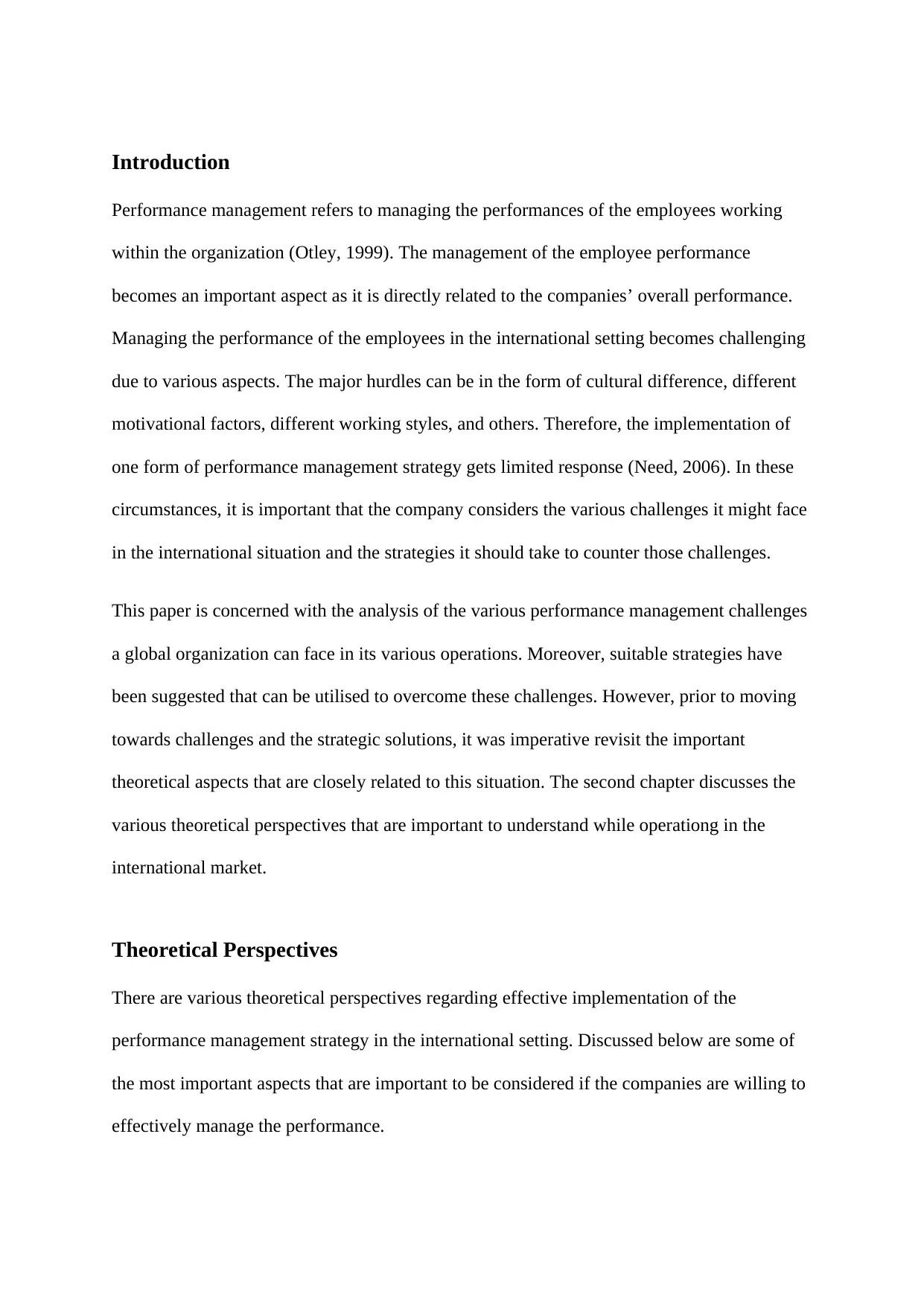
Introduction
Performance management refers to managing the performances of the employees working
within the organization (Otley, 1999). The management of the employee performance
becomes an important aspect as it is directly related to the companies’ overall performance.
Managing the performance of the employees in the international setting becomes challenging
due to various aspects. The major hurdles can be in the form of cultural difference, different
motivational factors, different working styles, and others. Therefore, the implementation of
one form of performance management strategy gets limited response (Need, 2006). In these
circumstances, it is important that the company considers the various challenges it might face
in the international situation and the strategies it should take to counter those challenges.
This paper is concerned with the analysis of the various performance management challenges
a global organization can face in its various operations. Moreover, suitable strategies have
been suggested that can be utilised to overcome these challenges. However, prior to moving
towards challenges and the strategic solutions, it was imperative revisit the important
theoretical aspects that are closely related to this situation. The second chapter discusses the
various theoretical perspectives that are important to understand while operationg in the
international market.
Theoretical Perspectives
There are various theoretical perspectives regarding effective implementation of the
performance management strategy in the international setting. Discussed below are some of
the most important aspects that are important to be considered if the companies are willing to
effectively manage the performance.
Performance management refers to managing the performances of the employees working
within the organization (Otley, 1999). The management of the employee performance
becomes an important aspect as it is directly related to the companies’ overall performance.
Managing the performance of the employees in the international setting becomes challenging
due to various aspects. The major hurdles can be in the form of cultural difference, different
motivational factors, different working styles, and others. Therefore, the implementation of
one form of performance management strategy gets limited response (Need, 2006). In these
circumstances, it is important that the company considers the various challenges it might face
in the international situation and the strategies it should take to counter those challenges.
This paper is concerned with the analysis of the various performance management challenges
a global organization can face in its various operations. Moreover, suitable strategies have
been suggested that can be utilised to overcome these challenges. However, prior to moving
towards challenges and the strategic solutions, it was imperative revisit the important
theoretical aspects that are closely related to this situation. The second chapter discusses the
various theoretical perspectives that are important to understand while operationg in the
international market.
Theoretical Perspectives
There are various theoretical perspectives regarding effective implementation of the
performance management strategy in the international setting. Discussed below are some of
the most important aspects that are important to be considered if the companies are willing to
effectively manage the performance.
⊘ This is a preview!⊘
Do you want full access?
Subscribe today to unlock all pages.

Trusted by 1+ million students worldwide
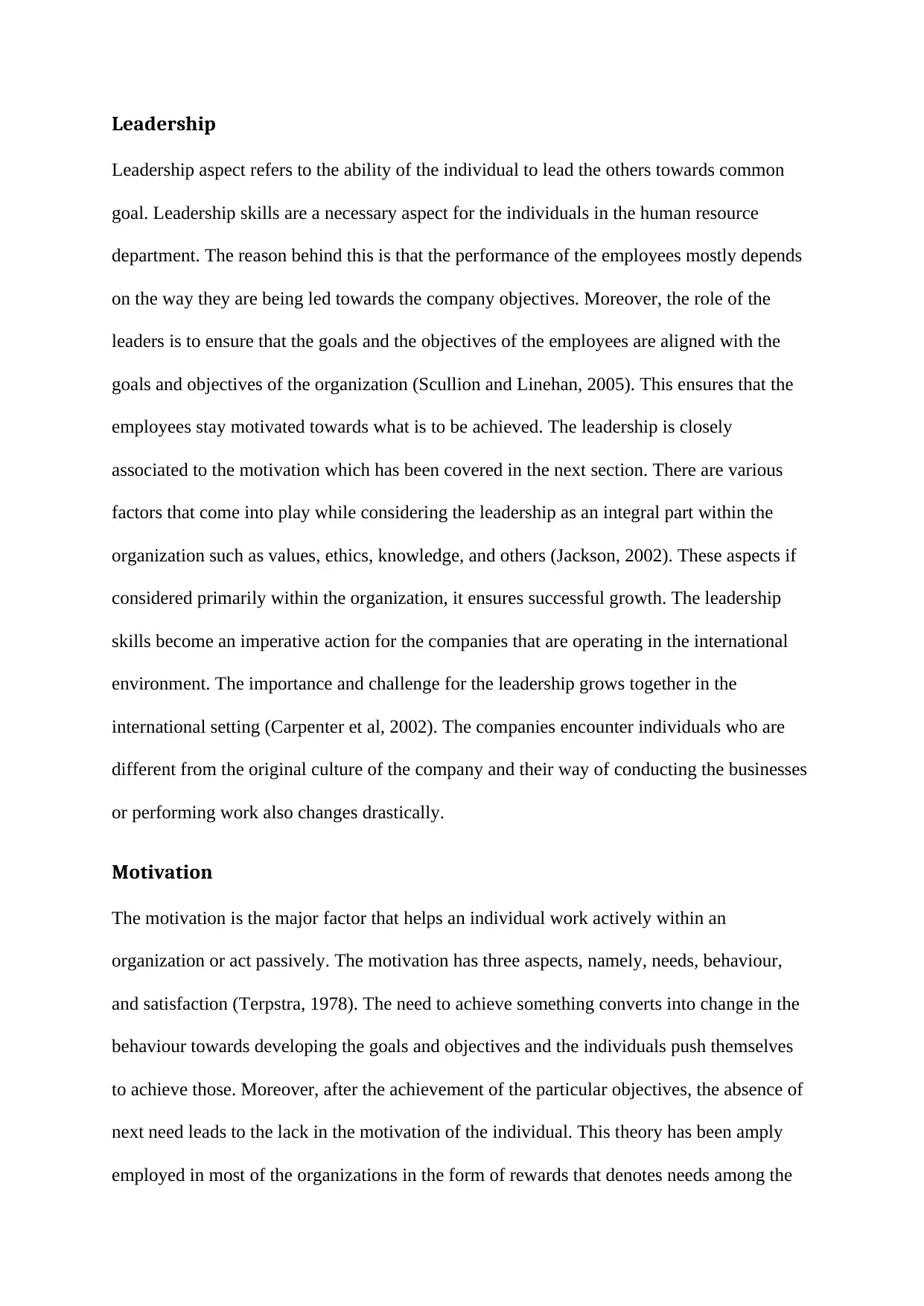
Leadership
Leadership aspect refers to the ability of the individual to lead the others towards common
goal. Leadership skills are a necessary aspect for the individuals in the human resource
department. The reason behind this is that the performance of the employees mostly depends
on the way they are being led towards the company objectives. Moreover, the role of the
leaders is to ensure that the goals and the objectives of the employees are aligned with the
goals and objectives of the organization (Scullion and Linehan, 2005). This ensures that the
employees stay motivated towards what is to be achieved. The leadership is closely
associated to the motivation which has been covered in the next section. There are various
factors that come into play while considering the leadership as an integral part within the
organization such as values, ethics, knowledge, and others (Jackson, 2002). These aspects if
considered primarily within the organization, it ensures successful growth. The leadership
skills become an imperative action for the companies that are operating in the international
environment. The importance and challenge for the leadership grows together in the
international setting (Carpenter et al, 2002). The companies encounter individuals who are
different from the original culture of the company and their way of conducting the businesses
or performing work also changes drastically.
Motivation
The motivation is the major factor that helps an individual work actively within an
organization or act passively. The motivation has three aspects, namely, needs, behaviour,
and satisfaction (Terpstra, 1978). The need to achieve something converts into change in the
behaviour towards developing the goals and objectives and the individuals push themselves
to achieve those. Moreover, after the achievement of the particular objectives, the absence of
next need leads to the lack in the motivation of the individual. This theory has been amply
employed in most of the organizations in the form of rewards that denotes needs among the
Leadership aspect refers to the ability of the individual to lead the others towards common
goal. Leadership skills are a necessary aspect for the individuals in the human resource
department. The reason behind this is that the performance of the employees mostly depends
on the way they are being led towards the company objectives. Moreover, the role of the
leaders is to ensure that the goals and the objectives of the employees are aligned with the
goals and objectives of the organization (Scullion and Linehan, 2005). This ensures that the
employees stay motivated towards what is to be achieved. The leadership is closely
associated to the motivation which has been covered in the next section. There are various
factors that come into play while considering the leadership as an integral part within the
organization such as values, ethics, knowledge, and others (Jackson, 2002). These aspects if
considered primarily within the organization, it ensures successful growth. The leadership
skills become an imperative action for the companies that are operating in the international
environment. The importance and challenge for the leadership grows together in the
international setting (Carpenter et al, 2002). The companies encounter individuals who are
different from the original culture of the company and their way of conducting the businesses
or performing work also changes drastically.
Motivation
The motivation is the major factor that helps an individual work actively within an
organization or act passively. The motivation has three aspects, namely, needs, behaviour,
and satisfaction (Terpstra, 1978). The need to achieve something converts into change in the
behaviour towards developing the goals and objectives and the individuals push themselves
to achieve those. Moreover, after the achievement of the particular objectives, the absence of
next need leads to the lack in the motivation of the individual. This theory has been amply
employed in most of the organizations in the form of rewards that denotes needs among the
Paraphrase This Document
Need a fresh take? Get an instant paraphrase of this document with our AI Paraphraser
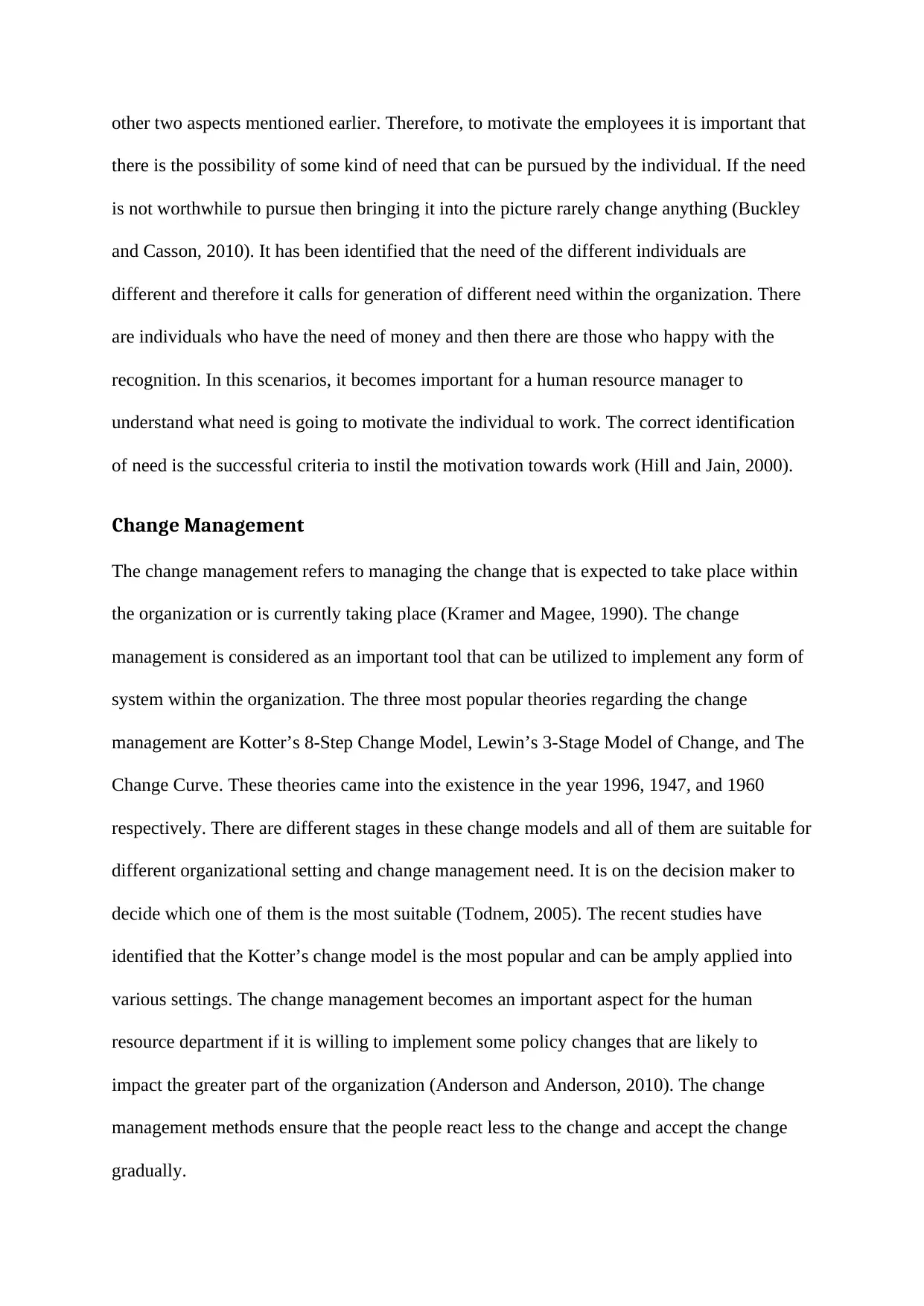
other two aspects mentioned earlier. Therefore, to motivate the employees it is important that
there is the possibility of some kind of need that can be pursued by the individual. If the need
is not worthwhile to pursue then bringing it into the picture rarely change anything (Buckley
and Casson, 2010). It has been identified that the need of the different individuals are
different and therefore it calls for generation of different need within the organization. There
are individuals who have the need of money and then there are those who happy with the
recognition. In this scenarios, it becomes important for a human resource manager to
understand what need is going to motivate the individual to work. The correct identification
of need is the successful criteria to instil the motivation towards work (Hill and Jain, 2000).
Change Management
The change management refers to managing the change that is expected to take place within
the organization or is currently taking place (Kramer and Magee, 1990). The change
management is considered as an important tool that can be utilized to implement any form of
system within the organization. The three most popular theories regarding the change
management are Kotter’s 8-Step Change Model, Lewin’s 3-Stage Model of Change, and The
Change Curve. These theories came into the existence in the year 1996, 1947, and 1960
respectively. There are different stages in these change models and all of them are suitable for
different organizational setting and change management need. It is on the decision maker to
decide which one of them is the most suitable (Todnem, 2005). The recent studies have
identified that the Kotter’s change model is the most popular and can be amply applied into
various settings. The change management becomes an important aspect for the human
resource department if it is willing to implement some policy changes that are likely to
impact the greater part of the organization (Anderson and Anderson, 2010). The change
management methods ensure that the people react less to the change and accept the change
gradually.
there is the possibility of some kind of need that can be pursued by the individual. If the need
is not worthwhile to pursue then bringing it into the picture rarely change anything (Buckley
and Casson, 2010). It has been identified that the need of the different individuals are
different and therefore it calls for generation of different need within the organization. There
are individuals who have the need of money and then there are those who happy with the
recognition. In this scenarios, it becomes important for a human resource manager to
understand what need is going to motivate the individual to work. The correct identification
of need is the successful criteria to instil the motivation towards work (Hill and Jain, 2000).
Change Management
The change management refers to managing the change that is expected to take place within
the organization or is currently taking place (Kramer and Magee, 1990). The change
management is considered as an important tool that can be utilized to implement any form of
system within the organization. The three most popular theories regarding the change
management are Kotter’s 8-Step Change Model, Lewin’s 3-Stage Model of Change, and The
Change Curve. These theories came into the existence in the year 1996, 1947, and 1960
respectively. There are different stages in these change models and all of them are suitable for
different organizational setting and change management need. It is on the decision maker to
decide which one of them is the most suitable (Todnem, 2005). The recent studies have
identified that the Kotter’s change model is the most popular and can be amply applied into
various settings. The change management becomes an important aspect for the human
resource department if it is willing to implement some policy changes that are likely to
impact the greater part of the organization (Anderson and Anderson, 2010). The change
management methods ensure that the people react less to the change and accept the change
gradually.
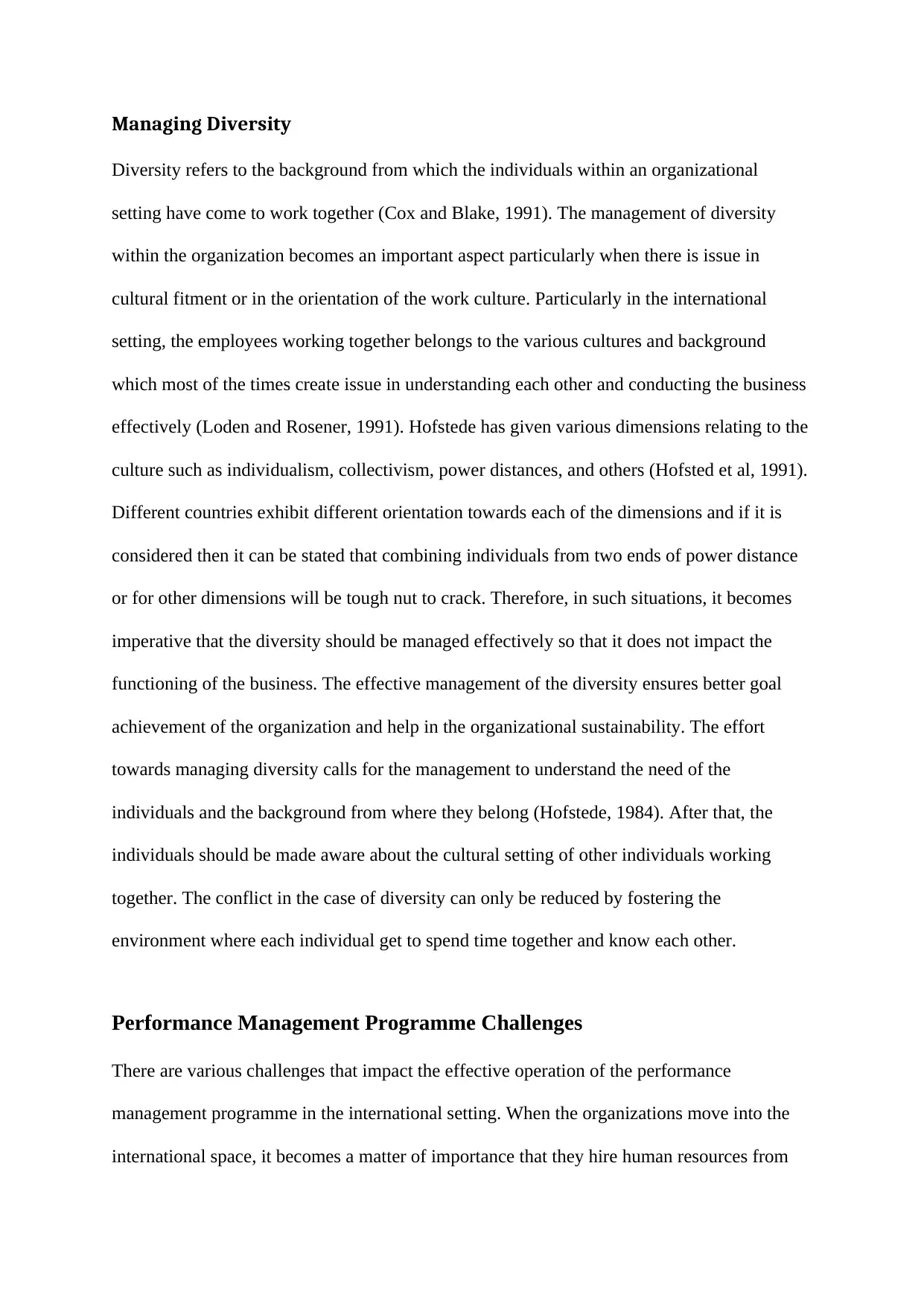
Managing Diversity
Diversity refers to the background from which the individuals within an organizational
setting have come to work together (Cox and Blake, 1991). The management of diversity
within the organization becomes an important aspect particularly when there is issue in
cultural fitment or in the orientation of the work culture. Particularly in the international
setting, the employees working together belongs to the various cultures and background
which most of the times create issue in understanding each other and conducting the business
effectively (Loden and Rosener, 1991). Hofstede has given various dimensions relating to the
culture such as individualism, collectivism, power distances, and others (Hofsted et al, 1991).
Different countries exhibit different orientation towards each of the dimensions and if it is
considered then it can be stated that combining individuals from two ends of power distance
or for other dimensions will be tough nut to crack. Therefore, in such situations, it becomes
imperative that the diversity should be managed effectively so that it does not impact the
functioning of the business. The effective management of the diversity ensures better goal
achievement of the organization and help in the organizational sustainability. The effort
towards managing diversity calls for the management to understand the need of the
individuals and the background from where they belong (Hofstede, 1984). After that, the
individuals should be made aware about the cultural setting of other individuals working
together. The conflict in the case of diversity can only be reduced by fostering the
environment where each individual get to spend time together and know each other.
Performance Management Programme Challenges
There are various challenges that impact the effective operation of the performance
management programme in the international setting. When the organizations move into the
international space, it becomes a matter of importance that they hire human resources from
Diversity refers to the background from which the individuals within an organizational
setting have come to work together (Cox and Blake, 1991). The management of diversity
within the organization becomes an important aspect particularly when there is issue in
cultural fitment or in the orientation of the work culture. Particularly in the international
setting, the employees working together belongs to the various cultures and background
which most of the times create issue in understanding each other and conducting the business
effectively (Loden and Rosener, 1991). Hofstede has given various dimensions relating to the
culture such as individualism, collectivism, power distances, and others (Hofsted et al, 1991).
Different countries exhibit different orientation towards each of the dimensions and if it is
considered then it can be stated that combining individuals from two ends of power distance
or for other dimensions will be tough nut to crack. Therefore, in such situations, it becomes
imperative that the diversity should be managed effectively so that it does not impact the
functioning of the business. The effective management of the diversity ensures better goal
achievement of the organization and help in the organizational sustainability. The effort
towards managing diversity calls for the management to understand the need of the
individuals and the background from where they belong (Hofstede, 1984). After that, the
individuals should be made aware about the cultural setting of other individuals working
together. The conflict in the case of diversity can only be reduced by fostering the
environment where each individual get to spend time together and know each other.
Performance Management Programme Challenges
There are various challenges that impact the effective operation of the performance
management programme in the international setting. When the organizations move into the
international space, it becomes a matter of importance that they hire human resources from
⊘ This is a preview!⊘
Do you want full access?
Subscribe today to unlock all pages.

Trusted by 1+ million students worldwide
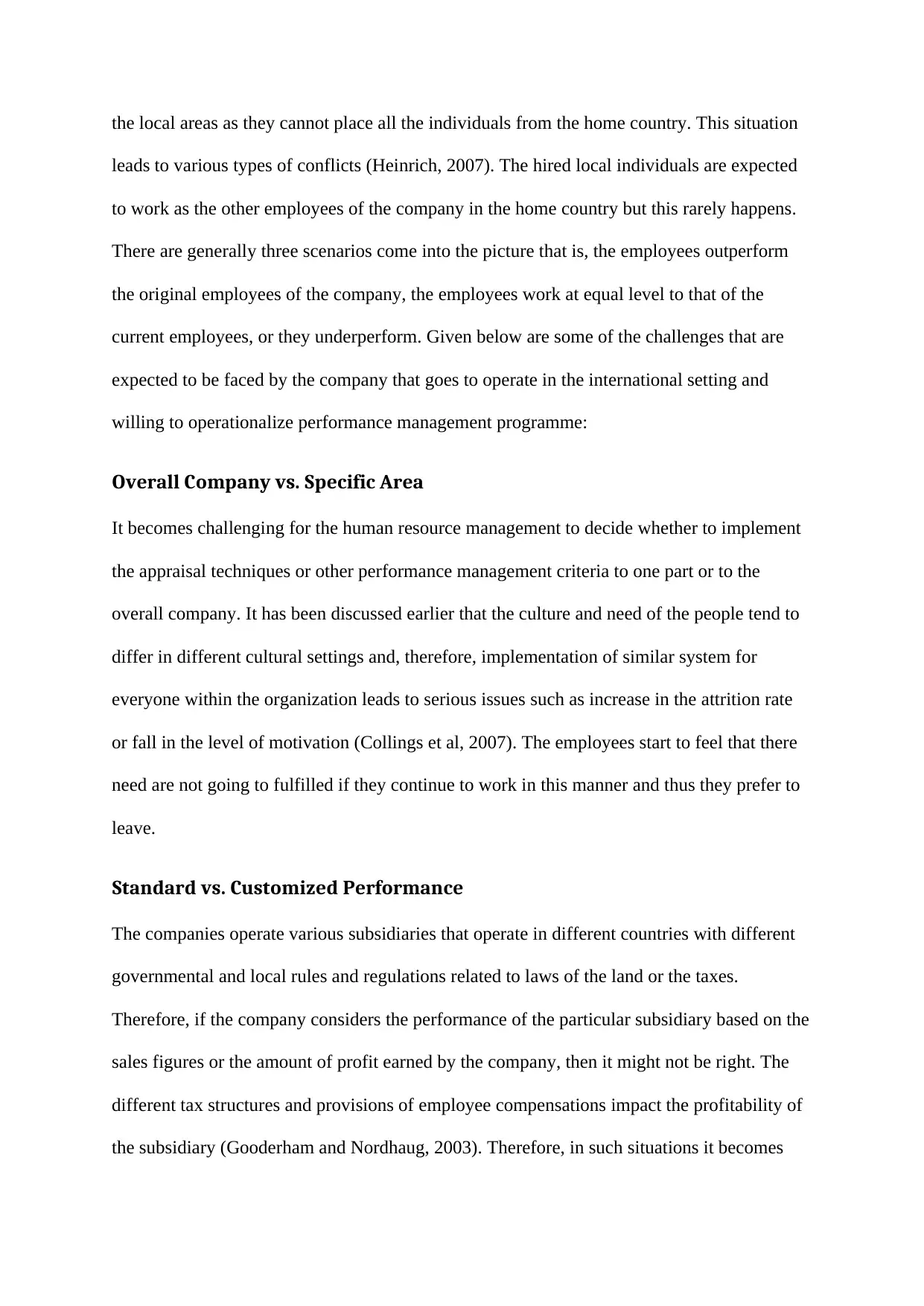
the local areas as they cannot place all the individuals from the home country. This situation
leads to various types of conflicts (Heinrich, 2007). The hired local individuals are expected
to work as the other employees of the company in the home country but this rarely happens.
There are generally three scenarios come into the picture that is, the employees outperform
the original employees of the company, the employees work at equal level to that of the
current employees, or they underperform. Given below are some of the challenges that are
expected to be faced by the company that goes to operate in the international setting and
willing to operationalize performance management programme:
Overall Company vs. Specific Area
It becomes challenging for the human resource management to decide whether to implement
the appraisal techniques or other performance management criteria to one part or to the
overall company. It has been discussed earlier that the culture and need of the people tend to
differ in different cultural settings and, therefore, implementation of similar system for
everyone within the organization leads to serious issues such as increase in the attrition rate
or fall in the level of motivation (Collings et al, 2007). The employees start to feel that there
need are not going to fulfilled if they continue to work in this manner and thus they prefer to
leave.
Standard vs. Customized Performance
The companies operate various subsidiaries that operate in different countries with different
governmental and local rules and regulations related to laws of the land or the taxes.
Therefore, if the company considers the performance of the particular subsidiary based on the
sales figures or the amount of profit earned by the company, then it might not be right. The
different tax structures and provisions of employee compensations impact the profitability of
the subsidiary (Gooderham and Nordhaug, 2003). Therefore, in such situations it becomes
leads to various types of conflicts (Heinrich, 2007). The hired local individuals are expected
to work as the other employees of the company in the home country but this rarely happens.
There are generally three scenarios come into the picture that is, the employees outperform
the original employees of the company, the employees work at equal level to that of the
current employees, or they underperform. Given below are some of the challenges that are
expected to be faced by the company that goes to operate in the international setting and
willing to operationalize performance management programme:
Overall Company vs. Specific Area
It becomes challenging for the human resource management to decide whether to implement
the appraisal techniques or other performance management criteria to one part or to the
overall company. It has been discussed earlier that the culture and need of the people tend to
differ in different cultural settings and, therefore, implementation of similar system for
everyone within the organization leads to serious issues such as increase in the attrition rate
or fall in the level of motivation (Collings et al, 2007). The employees start to feel that there
need are not going to fulfilled if they continue to work in this manner and thus they prefer to
leave.
Standard vs. Customized Performance
The companies operate various subsidiaries that operate in different countries with different
governmental and local rules and regulations related to laws of the land or the taxes.
Therefore, if the company considers the performance of the particular subsidiary based on the
sales figures or the amount of profit earned by the company, then it might not be right. The
different tax structures and provisions of employee compensations impact the profitability of
the subsidiary (Gooderham and Nordhaug, 2003). Therefore, in such situations it becomes
Paraphrase This Document
Need a fresh take? Get an instant paraphrase of this document with our AI Paraphraser
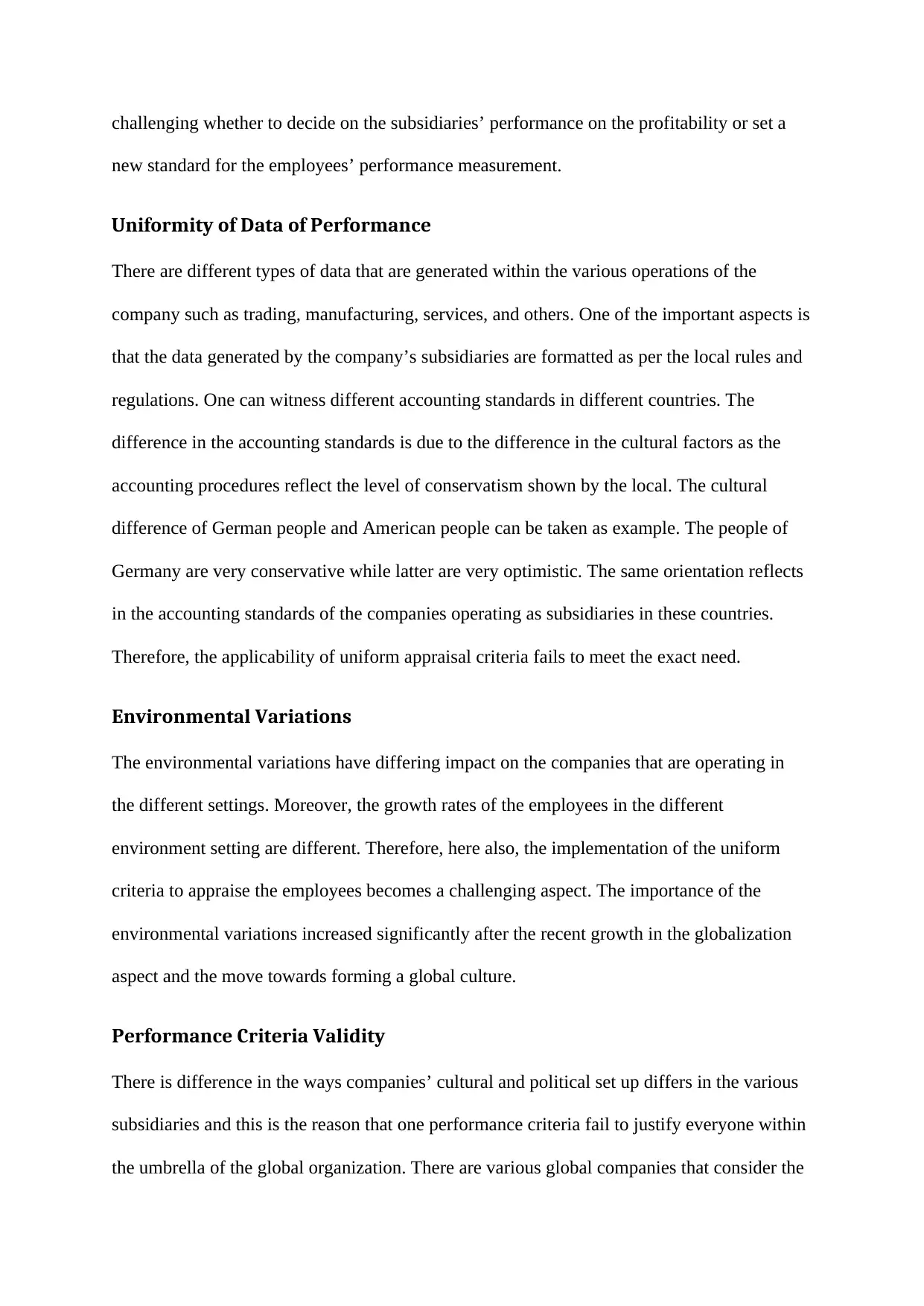
challenging whether to decide on the subsidiaries’ performance on the profitability or set a
new standard for the employees’ performance measurement.
Uniformity of Data of Performance
There are different types of data that are generated within the various operations of the
company such as trading, manufacturing, services, and others. One of the important aspects is
that the data generated by the company’s subsidiaries are formatted as per the local rules and
regulations. One can witness different accounting standards in different countries. The
difference in the accounting standards is due to the difference in the cultural factors as the
accounting procedures reflect the level of conservatism shown by the local. The cultural
difference of German people and American people can be taken as example. The people of
Germany are very conservative while latter are very optimistic. The same orientation reflects
in the accounting standards of the companies operating as subsidiaries in these countries.
Therefore, the applicability of uniform appraisal criteria fails to meet the exact need.
Environmental Variations
The environmental variations have differing impact on the companies that are operating in
the different settings. Moreover, the growth rates of the employees in the different
environment setting are different. Therefore, here also, the implementation of the uniform
criteria to appraise the employees becomes a challenging aspect. The importance of the
environmental variations increased significantly after the recent growth in the globalization
aspect and the move towards forming a global culture.
Performance Criteria Validity
There is difference in the ways companies’ cultural and political set up differs in the various
subsidiaries and this is the reason that one performance criteria fail to justify everyone within
the umbrella of the global organization. There are various global companies that consider the
new standard for the employees’ performance measurement.
Uniformity of Data of Performance
There are different types of data that are generated within the various operations of the
company such as trading, manufacturing, services, and others. One of the important aspects is
that the data generated by the company’s subsidiaries are formatted as per the local rules and
regulations. One can witness different accounting standards in different countries. The
difference in the accounting standards is due to the difference in the cultural factors as the
accounting procedures reflect the level of conservatism shown by the local. The cultural
difference of German people and American people can be taken as example. The people of
Germany are very conservative while latter are very optimistic. The same orientation reflects
in the accounting standards of the companies operating as subsidiaries in these countries.
Therefore, the applicability of uniform appraisal criteria fails to meet the exact need.
Environmental Variations
The environmental variations have differing impact on the companies that are operating in
the different settings. Moreover, the growth rates of the employees in the different
environment setting are different. Therefore, here also, the implementation of the uniform
criteria to appraise the employees becomes a challenging aspect. The importance of the
environmental variations increased significantly after the recent growth in the globalization
aspect and the move towards forming a global culture.
Performance Criteria Validity
There is difference in the ways companies’ cultural and political set up differs in the various
subsidiaries and this is the reason that one performance criteria fail to justify everyone within
the umbrella of the global organization. There are various global companies that consider the
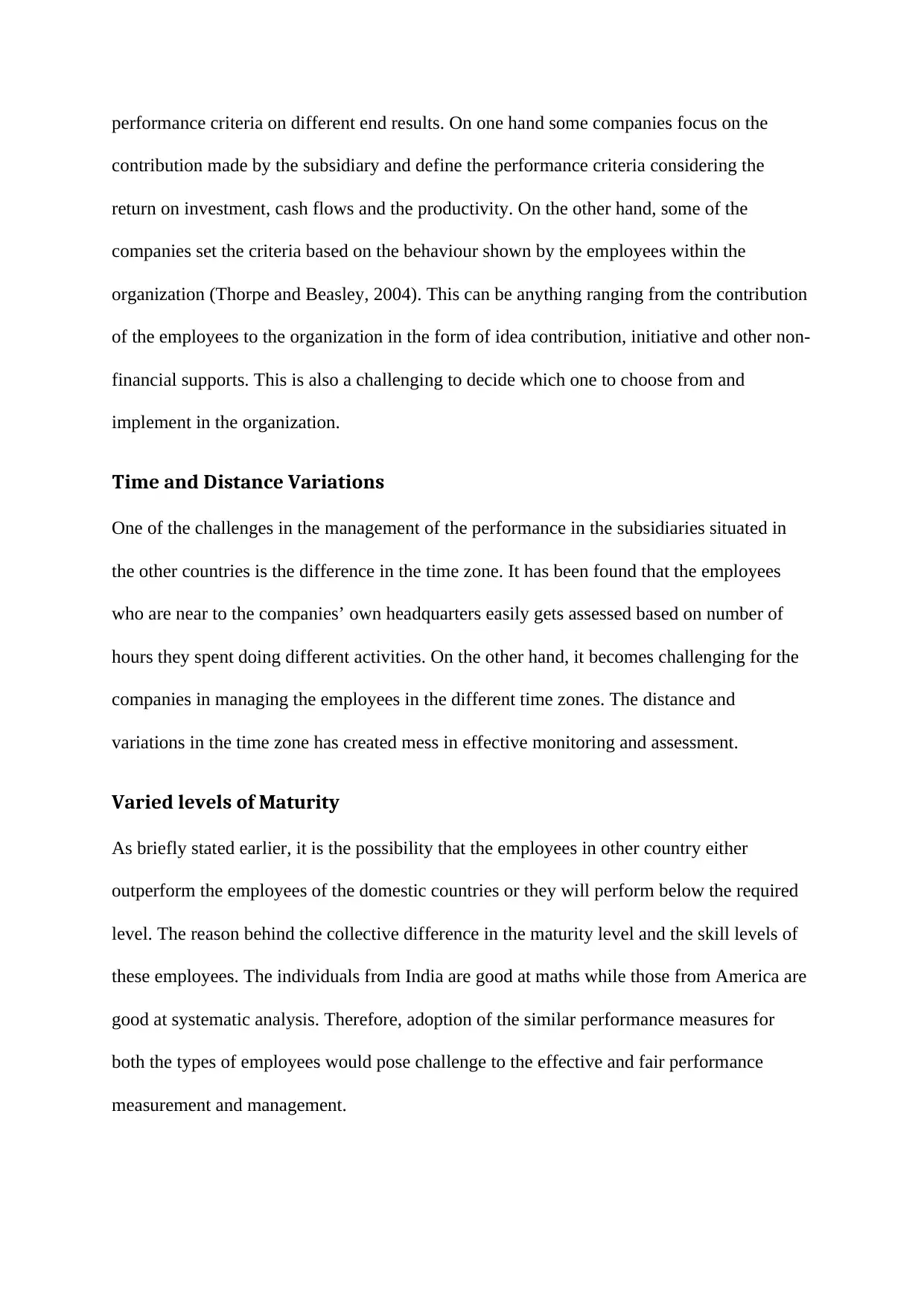
performance criteria on different end results. On one hand some companies focus on the
contribution made by the subsidiary and define the performance criteria considering the
return on investment, cash flows and the productivity. On the other hand, some of the
companies set the criteria based on the behaviour shown by the employees within the
organization (Thorpe and Beasley, 2004). This can be anything ranging from the contribution
of the employees to the organization in the form of idea contribution, initiative and other non-
financial supports. This is also a challenging to decide which one to choose from and
implement in the organization.
Time and Distance Variations
One of the challenges in the management of the performance in the subsidiaries situated in
the other countries is the difference in the time zone. It has been found that the employees
who are near to the companies’ own headquarters easily gets assessed based on number of
hours they spent doing different activities. On the other hand, it becomes challenging for the
companies in managing the employees in the different time zones. The distance and
variations in the time zone has created mess in effective monitoring and assessment.
Varied levels of Maturity
As briefly stated earlier, it is the possibility that the employees in other country either
outperform the employees of the domestic countries or they will perform below the required
level. The reason behind the collective difference in the maturity level and the skill levels of
these employees. The individuals from India are good at maths while those from America are
good at systematic analysis. Therefore, adoption of the similar performance measures for
both the types of employees would pose challenge to the effective and fair performance
measurement and management.
contribution made by the subsidiary and define the performance criteria considering the
return on investment, cash flows and the productivity. On the other hand, some of the
companies set the criteria based on the behaviour shown by the employees within the
organization (Thorpe and Beasley, 2004). This can be anything ranging from the contribution
of the employees to the organization in the form of idea contribution, initiative and other non-
financial supports. This is also a challenging to decide which one to choose from and
implement in the organization.
Time and Distance Variations
One of the challenges in the management of the performance in the subsidiaries situated in
the other countries is the difference in the time zone. It has been found that the employees
who are near to the companies’ own headquarters easily gets assessed based on number of
hours they spent doing different activities. On the other hand, it becomes challenging for the
companies in managing the employees in the different time zones. The distance and
variations in the time zone has created mess in effective monitoring and assessment.
Varied levels of Maturity
As briefly stated earlier, it is the possibility that the employees in other country either
outperform the employees of the domestic countries or they will perform below the required
level. The reason behind the collective difference in the maturity level and the skill levels of
these employees. The individuals from India are good at maths while those from America are
good at systematic analysis. Therefore, adoption of the similar performance measures for
both the types of employees would pose challenge to the effective and fair performance
measurement and management.
⊘ This is a preview!⊘
Do you want full access?
Subscribe today to unlock all pages.

Trusted by 1+ million students worldwide
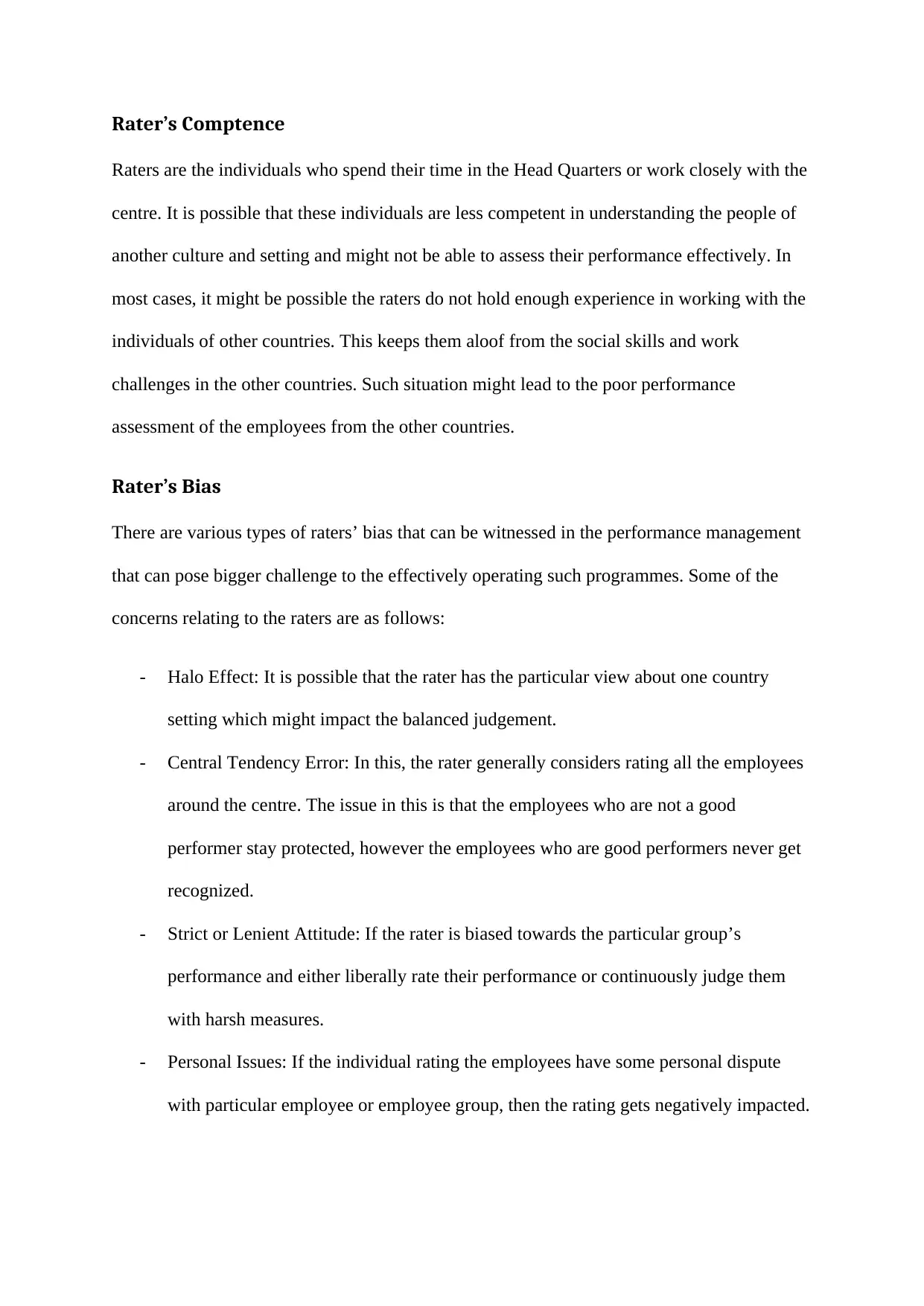
Rater’s Comptence
Raters are the individuals who spend their time in the Head Quarters or work closely with the
centre. It is possible that these individuals are less competent in understanding the people of
another culture and setting and might not be able to assess their performance effectively. In
most cases, it might be possible the raters do not hold enough experience in working with the
individuals of other countries. This keeps them aloof from the social skills and work
challenges in the other countries. Such situation might lead to the poor performance
assessment of the employees from the other countries.
Rater’s Bias
There are various types of raters’ bias that can be witnessed in the performance management
that can pose bigger challenge to the effectively operating such programmes. Some of the
concerns relating to the raters are as follows:
- Halo Effect: It is possible that the rater has the particular view about one country
setting which might impact the balanced judgement.
- Central Tendency Error: In this, the rater generally considers rating all the employees
around the centre. The issue in this is that the employees who are not a good
performer stay protected, however the employees who are good performers never get
recognized.
- Strict or Lenient Attitude: If the rater is biased towards the particular group’s
performance and either liberally rate their performance or continuously judge them
with harsh measures.
- Personal Issues: If the individual rating the employees have some personal dispute
with particular employee or employee group, then the rating gets negatively impacted.
Raters are the individuals who spend their time in the Head Quarters or work closely with the
centre. It is possible that these individuals are less competent in understanding the people of
another culture and setting and might not be able to assess their performance effectively. In
most cases, it might be possible the raters do not hold enough experience in working with the
individuals of other countries. This keeps them aloof from the social skills and work
challenges in the other countries. Such situation might lead to the poor performance
assessment of the employees from the other countries.
Rater’s Bias
There are various types of raters’ bias that can be witnessed in the performance management
that can pose bigger challenge to the effectively operating such programmes. Some of the
concerns relating to the raters are as follows:
- Halo Effect: It is possible that the rater has the particular view about one country
setting which might impact the balanced judgement.
- Central Tendency Error: In this, the rater generally considers rating all the employees
around the centre. The issue in this is that the employees who are not a good
performer stay protected, however the employees who are good performers never get
recognized.
- Strict or Lenient Attitude: If the rater is biased towards the particular group’s
performance and either liberally rate their performance or continuously judge them
with harsh measures.
- Personal Issues: If the individual rating the employees have some personal dispute
with particular employee or employee group, then the rating gets negatively impacted.
Paraphrase This Document
Need a fresh take? Get an instant paraphrase of this document with our AI Paraphraser
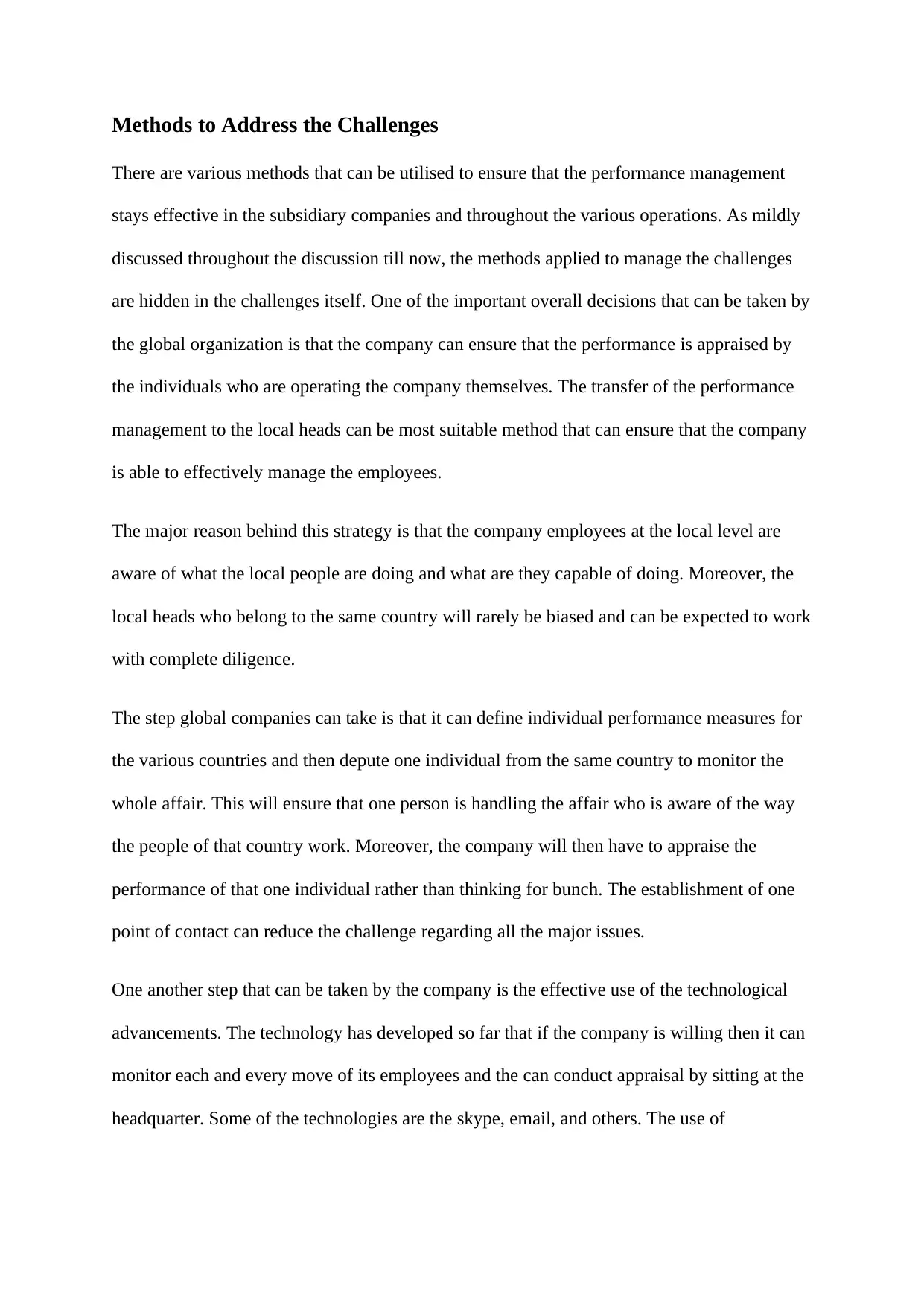
Methods to Address the Challenges
There are various methods that can be utilised to ensure that the performance management
stays effective in the subsidiary companies and throughout the various operations. As mildly
discussed throughout the discussion till now, the methods applied to manage the challenges
are hidden in the challenges itself. One of the important overall decisions that can be taken by
the global organization is that the company can ensure that the performance is appraised by
the individuals who are operating the company themselves. The transfer of the performance
management to the local heads can be most suitable method that can ensure that the company
is able to effectively manage the employees.
The major reason behind this strategy is that the company employees at the local level are
aware of what the local people are doing and what are they capable of doing. Moreover, the
local heads who belong to the same country will rarely be biased and can be expected to work
with complete diligence.
The step global companies can take is that it can define individual performance measures for
the various countries and then depute one individual from the same country to monitor the
whole affair. This will ensure that one person is handling the affair who is aware of the way
the people of that country work. Moreover, the company will then have to appraise the
performance of that one individual rather than thinking for bunch. The establishment of one
point of contact can reduce the challenge regarding all the major issues.
One another step that can be taken by the company is the effective use of the technological
advancements. The technology has developed so far that if the company is willing then it can
monitor each and every move of its employees and the can conduct appraisal by sitting at the
headquarter. Some of the technologies are the skype, email, and others. The use of
There are various methods that can be utilised to ensure that the performance management
stays effective in the subsidiary companies and throughout the various operations. As mildly
discussed throughout the discussion till now, the methods applied to manage the challenges
are hidden in the challenges itself. One of the important overall decisions that can be taken by
the global organization is that the company can ensure that the performance is appraised by
the individuals who are operating the company themselves. The transfer of the performance
management to the local heads can be most suitable method that can ensure that the company
is able to effectively manage the employees.
The major reason behind this strategy is that the company employees at the local level are
aware of what the local people are doing and what are they capable of doing. Moreover, the
local heads who belong to the same country will rarely be biased and can be expected to work
with complete diligence.
The step global companies can take is that it can define individual performance measures for
the various countries and then depute one individual from the same country to monitor the
whole affair. This will ensure that one person is handling the affair who is aware of the way
the people of that country work. Moreover, the company will then have to appraise the
performance of that one individual rather than thinking for bunch. The establishment of one
point of contact can reduce the challenge regarding all the major issues.
One another step that can be taken by the company is the effective use of the technological
advancements. The technology has developed so far that if the company is willing then it can
monitor each and every move of its employees and the can conduct appraisal by sitting at the
headquarter. Some of the technologies are the skype, email, and others. The use of
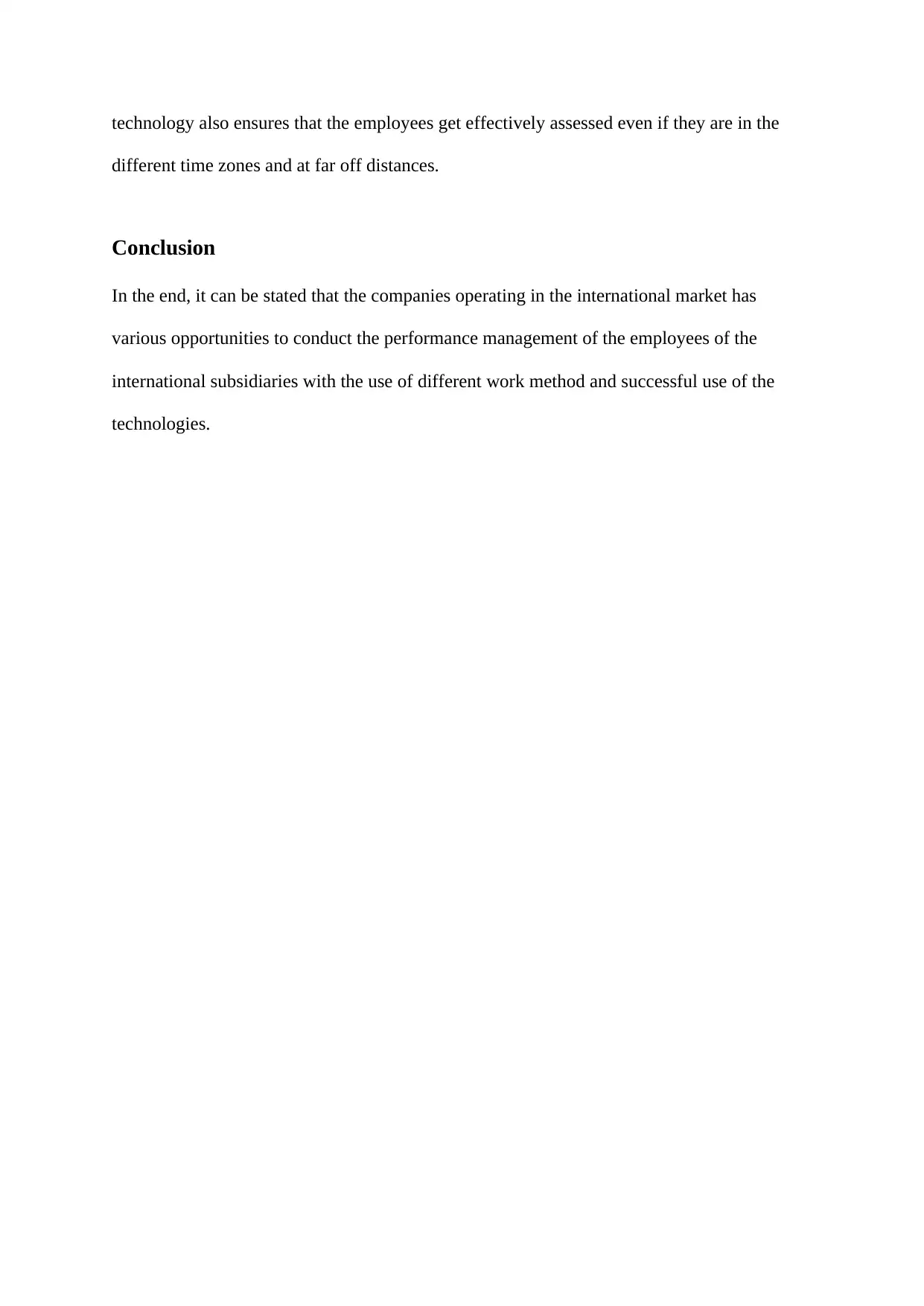
technology also ensures that the employees get effectively assessed even if they are in the
different time zones and at far off distances.
Conclusion
In the end, it can be stated that the companies operating in the international market has
various opportunities to conduct the performance management of the employees of the
international subsidiaries with the use of different work method and successful use of the
technologies.
different time zones and at far off distances.
Conclusion
In the end, it can be stated that the companies operating in the international market has
various opportunities to conduct the performance management of the employees of the
international subsidiaries with the use of different work method and successful use of the
technologies.
⊘ This is a preview!⊘
Do you want full access?
Subscribe today to unlock all pages.

Trusted by 1+ million students worldwide
1 out of 15
Related Documents
Your All-in-One AI-Powered Toolkit for Academic Success.
+13062052269
info@desklib.com
Available 24*7 on WhatsApp / Email
![[object Object]](/_next/static/media/star-bottom.7253800d.svg)
Unlock your academic potential
Copyright © 2020–2025 A2Z Services. All Rights Reserved. Developed and managed by ZUCOL.





